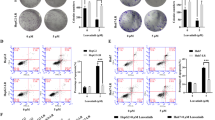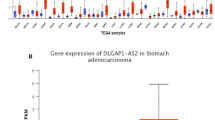Abstract
It is known that IL-17A inhibits autophagy of hepatocellular carcinoma (HCC) cells, thus contributing to the carcinogenesis of HCC. Starvation therapy can promote the autophagic death of HCC cells by blocking the nutrition supply. The purpose of this study was to explore whether the pharmacological antagonist of IL-17A, secukinumab, and starvation therapy have a synergistic effect on the autophagic cell death of HCC. Here, it could be observed that compared with serum-free condition, the combination of secukinumab and serum-free status better promoted autophagy (observed by LC3 conversion rate, p62 protein expression and the formation of autophagosomes), and more significantly inhibited the survival and function (observed by Trypan blue staining, CCK-8, Transwell, and scratch assays) in HCC HepG2 cells. Moreover, secukinumab significantly decreased BCL2 protein expression under serum-normal and serum-free conditions. However, both the addition of recombinant IL-17A and overexpression of BCL2 blocked the regulation of secukinumab on the survival and autophagy in HepG2 cells. Nude mice experiments demonstrated that compared to the lenvatinib-alone group, the combination group of lenvatinib and secukinumab better inhibited the in vivo tumorigenesis of HepG2 cells and enhanced autophagy in xenotumor tissues. Furthermore, secukinumab significantly decreased BCL2 protein expression in xenotumor tissues without or with lenvatinib application. In conclusion, the antagonism of IL-17A with secukinumab, due to the upregulation on BCL2-related autophagic cell death, can cooperate with starvation therapy in inhibiting HCC carcinogenesis. Our data suggested that secukinumab can become an effective adjuvant for the treatment of HCC.







Similar content being viewed by others
Data availability
The datasets generated during and/or analyzed during the current study are available from the corresponding author on reasonable request.
References
Brown DB, Nikolic B, Covey AM, Nutting CW, Saad WE, Salem R, Sofocleous CT, Sze DY; Society of Interventional Radiology Standards of Practice Committee (2012) Quality improvement guidelines for transhepatic arterial chemoembolization, embolization, and chemotherapeutic infusion for hepatic malignancy. J Vasc Interv Radiol 23(3):287–294
Cong LH, Li T, Wang H, Wu YN, Wang SP, Zhao YY, Zhang GQ, Duan J (2020) IL-17A-producing T cells exacerbate fine particulate matter-induced lung inflammation and fibrosis by inhibiting PI3K/Akt/mTOR-mediated autophagy. J Cell Mol Med 24(15):8532–8544
Fang T, Jiao Z, You Y, Cao J, Wang C, Liu J, Zhao W (2023) Lenvatinib inhibited HCC cell migration and invasion through regulating the transcription and ubiquitination of UHRF1 and DNMT1. Biochem Pharmacol 210:115489
Gomes AL, Teijeiro A, Burén S, Tummala KS, Yilmaz M, Waisman A, Theurillat JP, Perna C, Djouder N (2016) Metabolic inflammation-associated IL-17A causes non-alcoholic steatohepatitis and hepatocellular carcinoma. Cancer Cell 30(1):161–175
Gu FM, Li QL, Gao Q, Jiang JH, Zhu K, Huang XY, Pan JF, Yan J, Hu JH, Wang Z, Dai Z, Fan J, Zhou J (2011) IL-17 induces AKT-dependent IL-6/JAK2/STAT3 activation and tumor progression in hepatocellular carcinoma. Mol Cancer 10:150
Shi H, Wang J, Wang J, Huang Z, Yang Z (2018) IL-17A induces autophagy and promotes microglial neuroinflammation through ATG5 and ATG7 in intracerebral hemorrhage. J Neuroimmunol 323:143–151
Siegel RL, Miller KD, Fuchs HE (2021) Jemal A (2021) Cancer statistics. CA Cancer J Clin 71(1):7–33
Sung H, Ferlay J, Siegel RL, Laversanne M, Soerjomataram I, Jemal A et al (2021) Global cancer statistics 2020: GLOBOCAN estimates of incidence and mortality worldwide for 36 cancers in 185 countries. CA Cancer J Clin 71(3):209–249
Tateosian NL, Pellegrini JM, Amiano NO, Rolandelli A, Casco N, Palmero DJ, Colombo MI, García VE (2017) IL17A augments autophagy in Mycobacterium tuberculosis-infected monocytes from patients with active tuberculosis in association with the severity of the disease. Autophagy 13(7):1191–1204
Hilmi M, Neuzillet C, Calderaro J, Lafdil F, Pawlotsky JM, Rousseau B (2019) Angiogenesis and immune checkpoint inhibitors as therapies for hepatocellular carcinoma: current knowledge and future research directions. J Immunother Cancer 7(1):333
Hu J, Hu J, Wu W, Qin Y, Fu J, Zhou J, Liu C, Yin J (2022) N-acetyl-galactosamine modified metal-organic frameworks to inhibit the growth and pulmonary metastasis of liver cancer stem cells through targeted chemotherapy and starvation therapy. Acta Biomater 151:588–599
Huang A, Yang XR, Chung WY, Dennison AR, Zhou J (2020) Targeted therapy for hepatocellular carcinoma. Signal Transduct Target Ther 5(1):146
Langley RG, Elewski BE, Lebwohl M, Reich K, Griffiths CE, Papp K, Puig L, Nakagawa H, Spelman L, Sigurgeirsson B, Rivas E, Tsai TF, Wasel N, Tyring S, Salko T, Hampele I, Notter M, Karpov A, Helou S, Papavassilis C; ERASURE Study Group; FIXTURE Study Group (2014) Secukinumab in plaque psoriasis--results of two phase 3 trials. N Engl J Med 371(4):326–338
Li J, Lau GK, Chen L, Dong SS, Lan HY, Huang XR, Li Y, Luk JM, Yuan YF, Guan XY (2011) Interleukin 17A promotes hepatocellular carcinoma metastasis via NF-kB induced matrix metalloproteinases 2 and 9 expression. PLoS ONE 6(7):e21816
Li S, Lin Z, Zheng W, Zheng L, Chen X, Yan Z, Cheng Z, Yan H, Zheng C, Guo P (2019) IL-17A inhibits autophagic activity of HCC cells by inhibiting the degradation of Bcl2. Biochem Biophys Res Commun 509(1):194–200
Liu CC, Chen RH (2016) KLHL20 links the ubiquitin-proteasome system to autophagy termination. Autophagy 12(5):890–891
Liu T, Han S, Dai Q, Zheng J, Liu C, Li S, Li J (2019) IL-17A-mediated excessive autophagy aggravated neuronal ischemic injuries via Src-PP2B-mTOR pathway. Front Immunol 10:2952
Ma HY, Yamamoto G, Xu J, Liu X, Karin D, Kim JY, Alexandrov LB, Koyama Y, Nishio T, Benner C, Heinz S, Rosenthal SB, Liang S, Sun M, Karin G, Zhao P, Brodt P, Mckillop IH, Quehenberger O, Dennis E, Saltiel A, Tsukamoto H, Gao B, Karin M, Brenner DA, Kisseleva T (2020) IL-17 signaling in steatotic hepatocytes and macrophages promotes hepatocellular carcinoma in alcohol-related liver disease. J Hepatol 72(5):946–959
Ma S, Cheng Q, Cai Y, Gong H, Wu Y, Yu X, Shi L, Wu D, Dong C, Liu H (2014) IL-17A produced by γδ T cells promotes tumor growth in hepatocellular carcinoma. Cancer Res 74(7):1969–1982
Ni Z, Wang B, Dai X, Ding W, Yang T, Li X, Lewin S, Xu L, Lian J, He F (2014) HCC cells with high levels of Bcl-2 are resistant to ABT-737 via activation of the ROS-JNK-autophagy pathway. Free Radic Biol Med 70:194–203
Une N, Takano-Kasuya M, Kitamura N, Ohta M, Inose T, Kato C, Nishimura R, Tada H, Miyagi S, Ishida T, Unno M, Kamei T, Gonda K (2021) The anti-angiogenic agent lenvatinib induces tumor vessel normalization and enhances radiosensitivity in hepatocellular tumors. Med Oncol 38(6):60
Wang X, Qi H, Wang Q, Zhu Y, Wang X, Jin M, Tan Q, Huang Q, Xu W, Li X, Kuang L, Tang Y, Du X, Chen D, Chen L (2015) FGFR3/fibroblast growth factor receptor 3 inhibits autophagy through decreasing the ATG12-ATG5 conjugate, leading to the delay of cartilage development in achondroplasia. Autophagy 11(11):1998–2013
Wang Z, Wei Y, Lei L, Zhong J, Shen Y, Tan J, Xia M, Wu Y, Sun W, Chen L (2021) RANKL expression of primary osteoblasts is enhanced by an IL-17-mediated JAK2/STAT3 pathway through autophagy suppression. Connect Tissue Res 62(4):411–426
Xu QG, Yu J, Guo XG, Hou GJ, Yuan SX, Yang Y, Yang Y, Liu H, Pan ZY, Yang F, Gu FM, Zhou WP (2018) IL-17A promotes the invasion-metastasis cascade via the AKT pathway in hepatocellular carcinoma. Mol Oncol 12(6):936–952
Yang JD, Hainaut P, Gores GJ, Amadou A, Plymoth A, Roberts LR (2019) A global view of hepatocellular carcinoma: trends, risk, prevention and management. Nat Rev Gastroenterol Hepatol 16(10):589–604
Zhang A, Xiao Z, Liu Q, Li P, Xu F, Liu J, Tao H, Feng L, Song S, Liu Z, Huang G (2021) CaCO3 -encapuslated microspheres for enhanced transhepatic arterial embolization treatment of hepatocellular carcinoma. Adv Healthc Mater 10(19):e2100748
Zhang JP, Yan J, Xu J, Pang XH, Chen MS, Li L, Wu C, Li SP, Zheng L (2009) Increased intratumoral IL-17-producing cells correlate with poor survival in hepatocellular carcinoma patients. J Hepatol 50(5):980–989
Zhou Y, Wu PW, Yuan XW, Li J, Shi XL (2016) Interleukin-17A inhibits cell autophagy under starvation and promotes cell migration via TAB2/TAB3-p38 mitogen-activated protein kinase pathways in hepatocellular carcinoma. Eur Rev Med Pharmacol Sci 20(2):250–263
Zhu AX, Duda DG, Sahani DV, Jain RK (2011) HCC and angiogenesis: possible targets and future directions. Nat Rev Clin Oncol 8(5):292–301
Zou H, Tuhin IJ, Monty MA, Luo S, Shao J, Yan Z, Yu L (2020) Gene therapy for hepatocellular carcinoma using adenoviral vectors delivering a gene encoding IL-17A-neutralizing antibody fragments. Hum Gene Ther 31(19–20):1074–1085
Funding
This work was supported by the Provincial Natural Science Foundation of China Hainan (819MS119) and the Natural Science Foundation of Hainan General Hospital (QN202011).
Author information
Authors and Affiliations
Contributions
Zhensheng Zhang and Rong Tang conceived and designed the experiments; Rong Tang, Linmei Zheng, Jinfang Zheng, Jincai Wu, and Pingping Chen performed the experiments, analyzed the data, and prepared the figures; Jiacheng Chen, Dafeng Xu, Yongchao Zeng, and Qijin Li assisted in data analysis; Zhensheng Zhang and Rong Tang wrote the manuscript. All authors read and approved the manuscript.
Corresponding author
Ethics declarations
Competing interests
The authors declare no competing interests.
Additional information
Rong Tang and Linmei Zheng are considered co-first authors.
Supplementary Information
Below is the link to the electronic supplementary material.
Supplemental file 1
(JPG 97 kb)

Supplemental file 2
(PNG 474 kb)
Rights and permissions
Springer Nature or its licensor (e.g. a society or other partner) holds exclusive rights to this article under a publishing agreement with the author(s) or other rightsholder(s); author self-archiving of the accepted manuscript version of this article is solely governed by the terms of such publishing agreement and applicable law.
About this article
Cite this article
Tang, R., Zheng, L., Zheng, J. et al. Secukinumab plays a synergistic role with starvation therapy in promoting autophagic cell death of hepatocellular carcinoma via inhibiting IL-17A-increased BCL2 level. In Vitro Cell.Dev.Biol.-Animal 59, 381–393 (2023). https://doi.org/10.1007/s11626-023-00770-6
Received:
Accepted:
Published:
Issue Date:
DOI: https://doi.org/10.1007/s11626-023-00770-6




